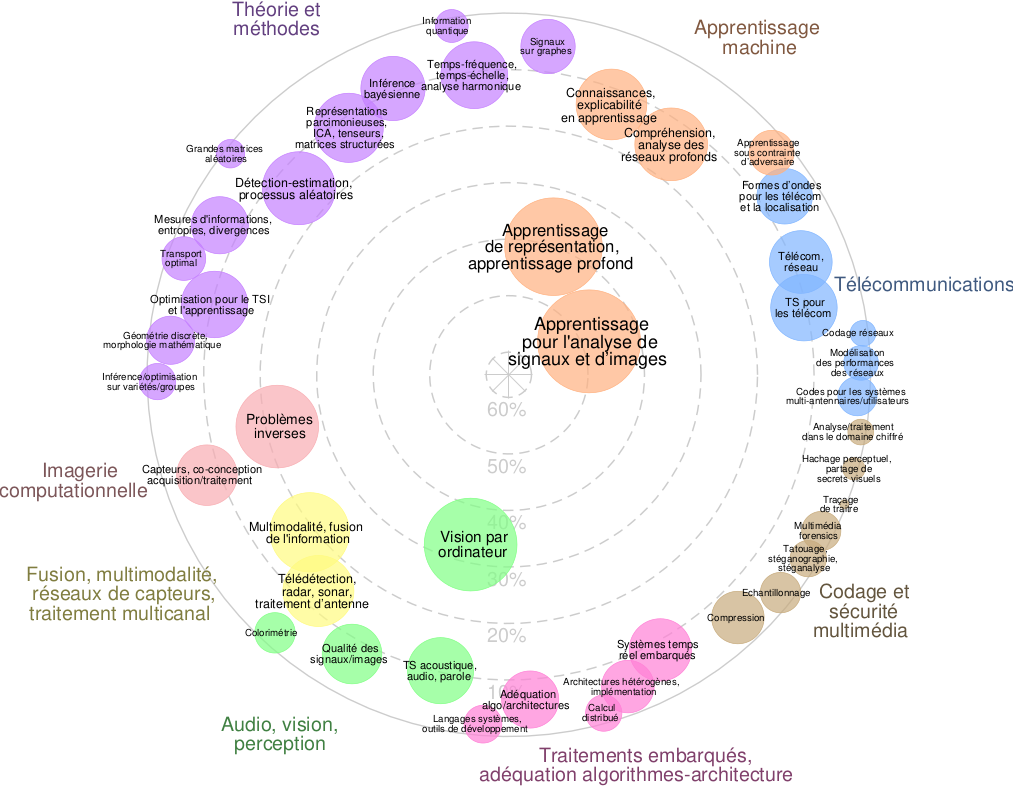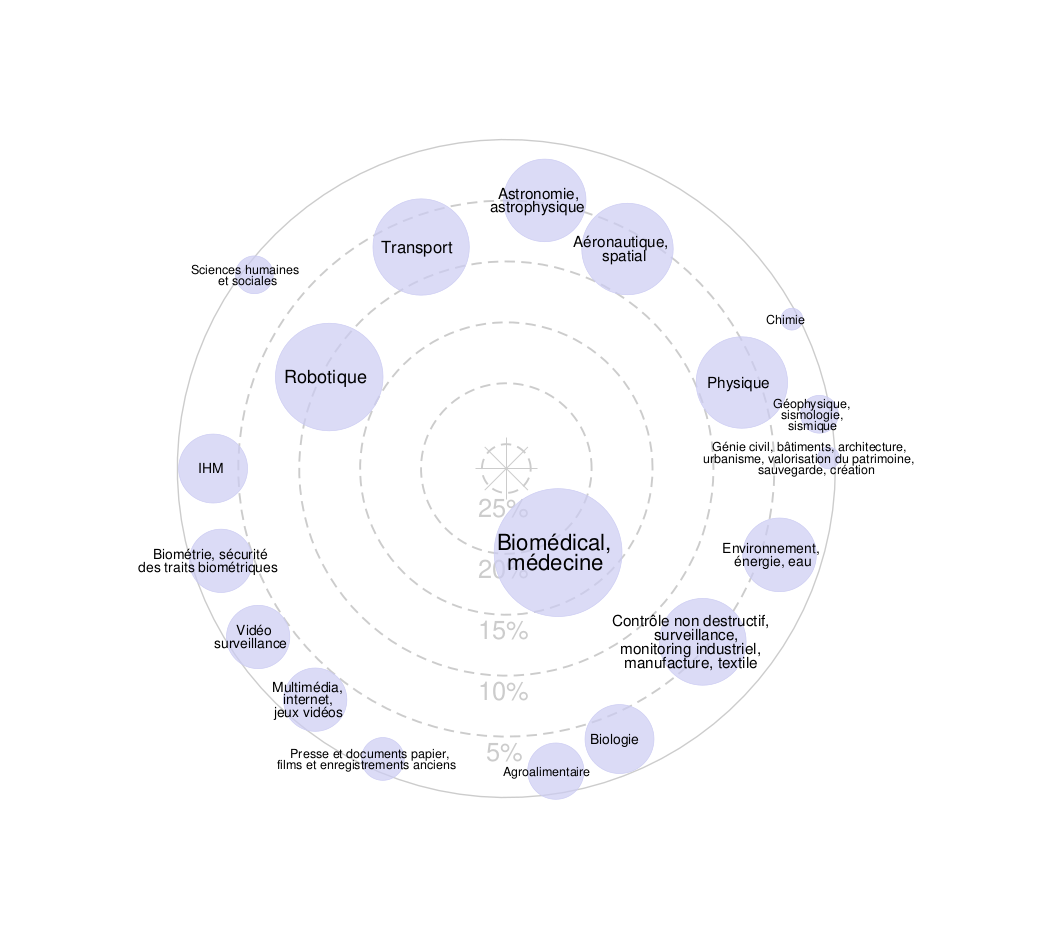Centre for Mathematical Morphology, and Centre for Material Sciences, MINES Paris PSL
Petr Dokladal, PhD, HDR, (PhD director), and Cristian Ovalle, PhD, HDR (PhD co-director)
Abstract:
This PhD assignment addresses the design of new materials, the properties of which are determined by their microstructure. It this scope:
- We will develop a new methodology to optimize various kinds of properties. In this project we will illustrate the methodology on the optimization of the resilience to mechanical failure.
- This methodology will leverage a hybrid AI architecture obtained by hybridization of a deep model and a numerical one. The deep AI part will formulate hypothesis in a virtual, meta-material space whereas the numerical model will constrain the AI to plausible material predictions.
- The key feature that we propose to explore is the ability of the AI to extrapolate outside the domain it has been trained to. The ability to extrapolate is paramount to formulate hypothesis to discover new meta-material parameters values.
These challenges cannot be answered using classical numerical tools. The alliance of AI and material science therefore opens hope to advance knowledge. It also has an economic and ecological impact on industry to ensure liability and durability of uncountable industrial products.
This project has been triggered by the availability of large datasets (micro-XCT data – in the Centre for Material Sciences) that allow the application of AI models to test new methods on real materials. In that way, the generated microstructures will conform to real materials and not only to theoretical solutions. Preliminary results to these attempts showed how to locally optimize the local distribution of the orientation of fibers in fiber-reinforced composites.
Methods:
This PhD will develop a hybrid, generative AI model to generate new, virtual 3D microstructures in a meta-material space. The samples will be predicted to respond to desired properties formulated by the user. We will develop the method on virtual data and prove the concept on real composites from micro-XCT datasets in CMAT. The hybridized AI will consist of the following:
- The generative AI model will stem upon classical generative models such as GAN or VAE. A few recent models, proven to generate high-resolution images and structures, appear as possible candidates, such as the inference-infoGAN [1], or the VQ-VAE-2 [2] that are the current SOtA method for high-quality generative model. The VQ-VAE-2 offers a two-stage latent space, with a compressed representation, where the material samples appear as entries in a codebook, allowing for high-fidelity image generation with an efficient sampling from interpretable latent space.
- The explainability of the model is a key feature besides its ability to generate high-quality 3D microstructures. In this effort, the model will be provided with a factorization[1] mechanism on its latent space, as introduced for info-GAN [3] based on the maximization of the mutual information between the latent and the output, or more recently in beta-VAE [4], offering a more stable, and easier training. In addition, we plan to use orthogonalization, to improve yet further the disentanglement, interpretability and regularity, as shown in [5], [6]. A good estimate of the latent space dimension is essential to isolate independent hidden variables as in [7], leveraging the Levina and Binkel [8] estimation of the intrinsic statistical dimension. We will identify influential variables related to the microstructure’s geometry. Applied to composite microstructure, these variables will represent physical variables, related to the geometry, such as the distribution of the length, orientation [9], [10], local density, or related to the material properties such as the shear and bulk modulus of the matrix and the ratio of the reinforcement and the matrix modulus.
- A numerical model will be hybridized with generative AI model. We will start with an elasto-plastic formulation modeling the multiaxial stress distribution in the composite. A multiaxial stress state is commonly linked with the material region where failure is observed – the Gurson-Tvergaard-Needleman (GTN) model [11] will be used to model damage for predicting ductile fracture of the composite. GTN describes the nucleation, growth, and coalescence of micro-voids, which are critical stages in the ductile mechanism failure. The numerical damage model will be used to simulate damage into the microstructure. Different microstructures will respond differently to the damage model.
- The hybridized AI model will generate new material samples. On each sample the AI model will predict the occurrence of damage. In this way a dense meta-material space can be generated. By sampling from the latent space new candidate microstructures can be generated by the generator along with their properties. A similar approach was also used in [12] where the optimality was reached by Bayesian optimization (see [13] for a SOtA review). Whereas the Bayesian optimization allows to optimize complex functions that are expensive to evaluate, particularly in scenarios where the function’s behavior is not explicitly known, the optimization is costly, and number of iterations can be high.
Expected results:
The principal advantages of the methodology we propose reside in:
- Using a disentangled and orthogonalized latent space for the generator allows an interpretable material search. The disentangled, orthogonalized representation in the lowest-possible-dimension latent space will allow for interpretability, and through better regularization also data frugality and faster convergence to optimal material.
- We showcase the new methodology on optimization of composites’ resilience. More generally however, this work belongs to the vast domain of material design. In this broader scope, we hope to develop a polyvalent method of material design that responds to more general properties of various kinds.
Literature:
[1] H. Jiang, J. Yin, X. Luo, et F. Wang, « Inference-InfoGAN: Inference Independence via Embedding Orthogonal Basis Expansion », 2 octobre 2021, arXiv: arXiv:2110.00788. doi: 10.48550/arXiv.2110.00788.
[2] A. Razavi, A. van den Oord, et O. Vinyals, « Generating Diverse High-Fidelity Images with VQ-VAE-2 », 2 juin 2019, arXiv: arXiv:1906.00446. doi: 10.48550/arXiv.1906.00446.
[3] X. Chen, Y. Duan, R. Houthooft, J. Schulman, I. Sutskever, et P. Abbeel, « InfoGAN: Interpretable Representation Learning by Information Maximizing Generative Adversarial Nets », 12 juin 2016, arXiv: arXiv:1606.03657. doi: 10.48550/arXiv.1606.03657.
[4] I. Higgins et al., « beta-VAE: Learning Basic Visual Concepts with a Constrained Variational Framework », présenté à International Conference on Learning Representations, févr. 2017. Consulté le: 24 mars 2025. [En ligne]. Disponible sur: https://openreview.net/forum?id=Sy2fzU9gl
[5] F. Meng, P. Tang, F. jiang, et M. Zhang, « CLOVER: Cross-Layer Orthogonal Vectors Pruning and Fine-Tuning », 31 janvier 2025, arXiv: arXiv:2411.17426. doi: 10.48550/arXiv.2411.17426.
[6] J. Cha et J. Thiyagalingam, « Orthogonality-enforced latent space in autoencoders: an approach to learning disentangled representations », in Proceedings of the 40th International Conference on Machine Learning, in ICML’23, vol. 202. Honolulu, Hawaii, USA: JMLR.org, juill. 2023, p. 3913‑3948.
[7] B. Chen, K. Huang, S. Raghupathi, I. Chandratreya, Q. Du, et H. Lipson, « Discovering State Variables Hidden in Experimental Data », 20 décembre 2021, arXiv: arXiv:2112.10755. Consulté le: 1 août 2022. [En ligne]. Disponible sur: http://arxiv.org/abs/2112.10755
[8] E. Levina et P. J. Bickel, « Maximum Likelihood Estimation of Intrinsic Dimension », p. 8.
[9] E. Mofakhami et al., « Microstructure-mechanical properties relationships in vibration welded glass-fiber-reinforced polyamide 66: A high-resolution X-ray microtomography study », Polymer Testing, vol. 85, p. 106454, mai 2020, doi: 10.1016/j.polymertesting.2020.106454.
[10] E. Mofakhami, L. Gervat, B. Fayolle, G. Miquelard-Garnier, C. Ovalle, et L. Laiarinandrasana, « Effect of fibre concentration on the mechanical properties of welded reinforced polypropylene », Composites Part B: Engineering, vol. 269, p. 111111, janv. 2024, doi: 10.1016/j.compositesb.2023.111111.
[11] V. Tvergaard et A. Needleman, « Analysis of the cup-cone fracture in a round tensile bar », Acta Metallurgica, vol. 32, no 1, p. 157‑169, janv. 1984, doi: 10.1016/0001-6160(84)90213-X.
[12] D.-Y. Wu et T. C. Hufnagel, « Efficient searching of processing parameter space to enable inverse microstructural design of materials », Acta Materialia, vol. 264, p. 119562, janv. 2024, doi: 10.1016/j.actamat.2023.119562. [13] X. Zheng, X. Zhang, T.-T. Chen, et I. Watanabe, « Deep Learning in Mechanical Metamaterials: From Prediction and Generation to Inverse Design », Advanced Materials, vol. 35, no 45, p. 2302530, 2023, doi: 10.1002/adma.202302530.
[13] X. Zheng, X. Zhang, T.-T. Chen, et I. Watanabe, « Deep Learning in Mechanical Metamaterials: From Prediction and Generation to Inverse Design », Advanced Materials, vol. 35, no 45, p. 2302530, 2023, doi: 10.1002/adma.202302530.
Sucessful candidate’s profile:
A successful candidate will have accomplished a master level engineering studies in the domain of AI possibly related to engineering. Coding proficiency with python and related AI tools (tensorflow, torch) are essential. Excellent communication skills (oral and writing). English proficiency – Cambridge C2 required.
An application file with the following elements is to be sent to petr.dokladal@minesparis.psl.eu :
– a detailed resume, and academic transcription containing latest grade reports
– a cover letter explaining the applicant’s motivation for the position
– two reference contacts: names and contact to at least two people to contact to provide a reference on the candidate





